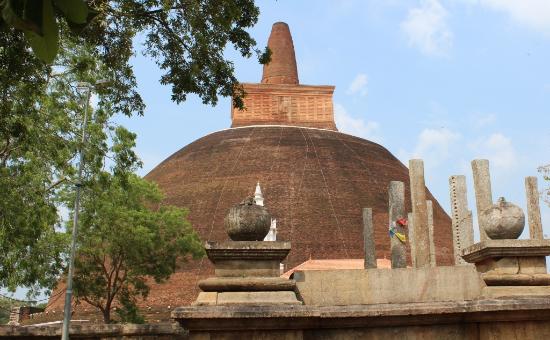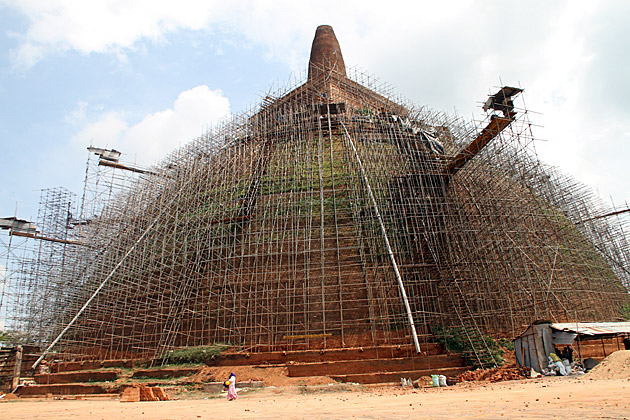Abhayagiri Vihāra was a major monastery site of Mahayana and Theravada Buddhism that was situated in Anuradhapura, Sri Lanka. It is one of the most extensive ruins in the world and one of the most sacred Buddhist pilgrimage cities in the nation. Historically it was a great monastic centre as well as a royal capital, with magnificent monasteries rising to many stories, roofed with gilt bronze or tiles of burnt clay glazed in brilliant colors. To the north of the city, encircled by great walls and containing elaborate bathing ponds, carved balustrades and moonstones, stood "Abhayagiri", one of seventeen such religious units in Anuradhapura and the largest of its five major viharas. One of the focal points of the complex is an ancient stupa, the Abhayagiri Dagaba. Surrounding the humped dagaba, Abhayagiri Vihara was a seat of the Northern Monastery, or Uttara Vihara.
Abhayagiri stupa belongs to the aramic complex of Abhayagiriya Viharaya which was constructed in the reign of King Vattagamini Abaya (commonly known as King Valagamba) in the 1st Century BC.
Today, the main attraction of this aramaic complex is the massive Abayagiri Stupa which stands at 74.98 meters to the tip of the damaged spire. It is the second largest stupa in the island today. According to the 5th century traveler Chinese monk Fa-Hsien’s descriptions, this stupa has been 400 feet (122 meters) in height and has been decorated with gold and silver and studded with all kinds of jewels. There also has been a 20 foot (6.1 meters) high Buddha statue made out of green jade.
Today, the main attraction of this aramaic complex is the massive Abayagiri Stupa which stands at 74.98 meters to the tip of the damaged spire. It is the second largest stupa in the island today. According to the 5th century traveler Chinese monk Fa-Hsien’s descriptions, this stupa has been 400 feet (122 meters) in height and has been decorated with gold and silver and studded with all kinds of jewels. There also has been a 20 foot (6.1 meters) high Buddha statue made out of green jade.
The story of the birth of this aramic complex is very interesting. According to the chronicles, soon after the king Vattagamini Abaya ascended to the throne in 104 BC, a Tamil invasion took place. The new king unable to withstand the attack, was retreating from the capital. At this time a Jain monk was residing in the area which Abhayagiri stands today. When the king was passing this area the Jain monk named “Geri” shouted insultingly “Lo the great black Sinhala king is in flight”.
The king ignored this comment but when he came back to Anuradhapura after 14 years after defeating the the invaders, he has not forgotten this incident. The king razed this hermitage to the ground and built a massive stupa and 12 buildings and offered it to Mahathissa Thero. The stupa was named by coining the two rivals names “Abaya” (The king’s name) and “Geri” (The Jain monk) – The “Abayagiri” Later, this vihara became a rival to Mahavihara. Mahaviharians were followers of pure “Theravada Buddhism” and the priests at the Abayagiri were open to more ideas and followed principles of both Theravada and Mahayana teachings.











No comments:
Post a Comment